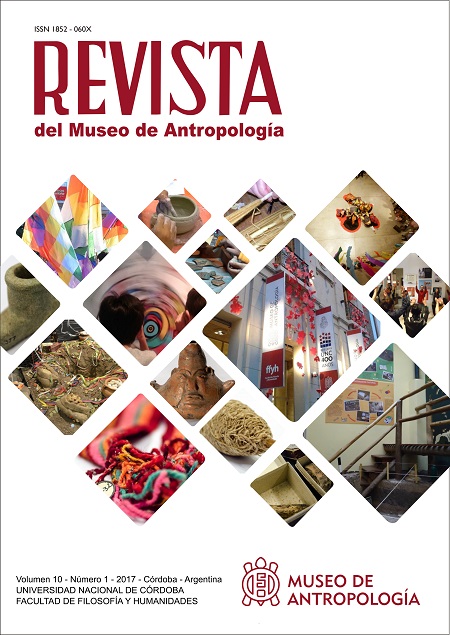Museums and intergenerational linkage. Assessment study of an educational proposal
DOI:
https://doi.org/10.31048/1852.4826.v10.n1.15896Keywords:
museums, intergenerational linkage, creativity, educationAbstract
Museums are presented as social spaces. Places to and interact with others, and to link different generations. Children and adults exchange their ideas about objects, the history, and about stories that are passed on. Museums resort to different strategies to convene families. One of the strategies has been games and toys. We present theoretical perspectives on museums and intergenerational linkage, childhood and old age as social constructions and games and toys as opportunities for creativity in museums. We describe a study on the evaluation of the participants of a proposal developed in a museum in the city of Río Cuarto called Spaces to meet: games and toys in the museum. As a result, we can highlight the positive responses of the participants, considering that the proposal allows for sharing an enriching experience in social terms.Downloads
References
Alderoqui, S y Pedersoli, C (2011). La educación en los museos. De los objetos a los visitantes. Argentina: Buenos Aires. Paidós.
Alderoqui, S y Linares, M. C (2012). Tesoros de la nostalgia, porvenir de una ilusión. En Alderoqui, S. (Coord.) Los visitantes como patrimonio. El Museo de la Escuelas. Buenos Aires Ciudad. http://www.buenosaires.gob.ar/sites/gcaba/files/losvisitantescomopatrimonio_0.pdf.(02/12/16).
Beghetto, R. A. (2016). Creative learning: A fresh look. Journal of Cognitive Education and Psychology, 15(1), pp. 6-23.
Comfort, A. (1997). Una buena edad: la tercera edad. Madrid. Ed. Debate.
CornachioneLarrínaga. M. A. (2006). Psicología del desarrollo. Aspectos biológicos, psicológicos y sociales. Córdoba: Ed. Brujas.
Doering, D. Z. (2010). “Strangers, Guests, orClients? VisitorExperiences in Museums”, Curator. TheMuseumJournal, 42: 74-87.
Domínguez, A. (2003). La museología participativa. La función de los educadores de museo. Actas de los XIII Cursos Monográficos sobre Patrimonio Histórico. (99- 117). Reinosa.
Ende, M. (2008). Momo. Mexico. Ed. Alfaguara juvenil.
Escarbajal De Haro, A y Mártinez de Miguel López, S (2012). El papel de la educación y los museos en la inclusión social. Una contribución desde la animación sociocultural. Revista Educatio Siglo XXI, 30 (2): 445-466.
Falk, J. H. (2009). Identity and theMuseumVisitorExperience. Walnut Creek. Ed. LeftCoastPress, Inc.
Falk, J. y Dierking, L. 2000. Learning from museums.Visitor experiences and the making of meaning.Estados Unidos. Ed. Altamira Press.
Glåveanu, V. P. (2015). Creativity as a sociocultural act. The Journal of Creative Behavior, 49(3), pp. 165-180.
Hood, M (1983). Staying away. Why people choose not the visit museums. Museum News, 61(4), 50-57.
Imach Cohen, S. (2010) Infancia Maltratada en la Posmodernidad. Teoría Clínica y Evaluación. Buenos Aires. Ed. Paidós.
Kaufman, J. y Beghetto, R. (2009). Beyond big and little: The Four C Model of creativity. Review of General Psychology, 13(1), pp. 1–12.
Maceira Ochoa, L (2008). Los museos en la educación de personas jóvenes y adultas.Revista Interamericana de Educación de Adultos, 1, (30): pp. 47-76.
Melgar, M. F y Elisondo. R (2016). Museos, formación profesional e innovación educativa en la universidad. Revista Contextos de Educación. Universidad Nacional de Río Cuarto. (En prensa). Aceptado en septiembre
Montenegro, Ana M, y Ridao, Angela. (2014). Los juguetes de la infancia: intervención y diálogo intergeneracional. Espacios en blanco. Serie indagaciones, 24(1): 127-150. http://www.scielo.org.ar/scielo.php?script=sci_arttext&pid=S1515-94852014000100009. (02/12/16).
Morales Gómez, E (2015). Nuevos formatos educativos para la comunidad en centros de arte. De los talleres de familia a los talleres intergeneracionales: un estudio de caso en Matadero-Madrid. Facultad de Bellas Artes. Universidad Complutense de Madrid. España. Pág. 416. Tesis Doctotal. Dialnet.
Ortiz Moreno, J y Álvarez Domínguez, P (2016). Una mirada a los juegos y juguetes del ayer. Encuentro intergeneracional entre abuelos/as y nietos/as para la recuperación del patrimonio educativo. Cabás, 15: 154-166. http://revista.muesca.es/documentos/cabas15/7-%20Encuetro%20intergeneracional.pdf. (02/12/16).
Tuninetti, V (2016). Salir del museo. Propuesta Cultural en contextos de encierro. En Melgar, M.F y Elisondo, R (Comp.) Museos y Educación. Buscando musas. Ed. Cuadernos de Educación. La Laguna: Sociedad Latina de Comunicación Social. Recuperado el 25 de mayo de http://www.cuadernosartesanos.org/2017/cde06.pdf.
Varela Nieto, P y Martínez Montalbán, J-L (2005). Jugando a divulgar la física con juguetes. Revista Eureka sobre Enseñanza y Divulgación de las Ciencias, 2(2): 234-240.
Villar Posada, F. (2005). El enfoque del ciclo vital: hacia un abordaje evolutivo delenvejecimiento.EnBeltran Lavador, JGerontología: Actualización, Innovación y Propuestas. España. Ed. Pearson Educación.
Zabala, M. E y De Carli, M. C (2015) La “noche” construida por los visitantes del Museo de Antropología FFyH-UNC. Caso de estudio, la Noche de los Museos. Revista del Museo de Antropología. 8 (1): 125-132.
Downloads
Published
Issue
Section
License
Those authors who have publications with this Journalaccept the following terms:
a. Authors will retain their copyrights and guarantee the journal the right of first publication of their work, which will be simultaneously subject to the Creative Commons Attribution License (Licencia de reconocimiento de Creative Commons) that allows third parties to share the work as long as its author and his first publication in this journal.
b. Authors may adopt other non-exclusive licensing agreements for the distribution of the version of the published work (eg, deposit it in an institutional electronic file or publish it in a monographic volume) provided that the initial publication in this journal is indicated.
c. Authors are allowed and recommended to disseminate their work on the Internet (eg in institutional telematic archives or on their website) before and during the submission process, which can lead to interesting exchanges and increase citations of the published work. (See The Effect of Open Access - El efecto del acceso abierto)












